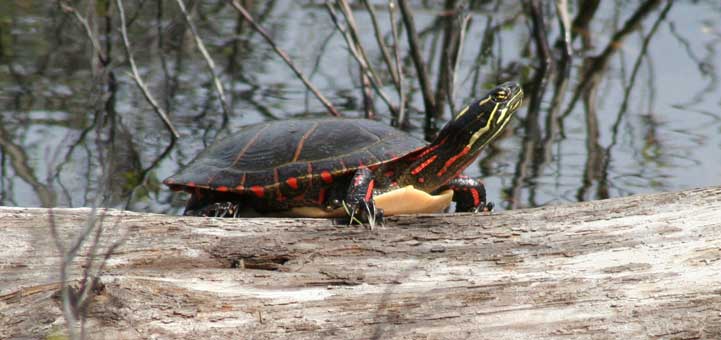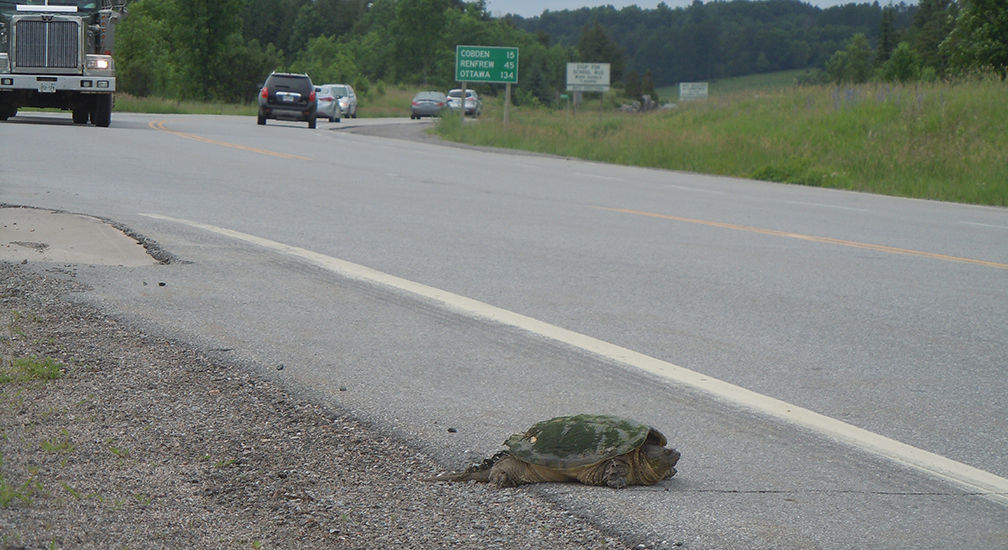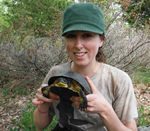Ontario Nature Blog
Receive email alerts about breaking conservation
and environmental news.
© Lora Denis
Midland painted turtle © Peter Ferguson
When Ontario Nature’s conservation staff drive around the province for field work it’s never relaxing. Instead of sitting back and watching the scenery, we keep our eyes pinned to the road in search of reptiles or amphibians, dead or alive.
Having spent all last summer training my eyes to pick up every herp-shaped object on the road it’s now second nature to spot both live and dead critters. This is both a blessing and a curse. It’s great that I can help turtles cross roads and submit road mortality data to the Reptile and Amphibian Atlas, but the number of times I’ve pulled over to ID what actually turned out to be a banana peel is bordering on ridiculous.
However this visual prowess came in handy last week, when Jenna, an Ontario Nature intern, and I were driving to Petrel Point Nature Reserve on the Bruce Peninsula and spotted a black and yellow object spin-out beneath the tire of a truck. It looked distinctly turtle-like so we pulled over to check it out. It was a female midland painted turtle. She had been nicked by the truck as it passed, and suffered a deep gash in her plastron (the underside of its shell), and was missing a chunk of her carapace (the upper part of its shell). Despite this she was alive and able to move. We immediately called James Paterson, Ontario Nature’s herp expert, to find out what to do.

James directed us to put the turtle in a container with air holes, not in water, and to place the container in a cool, dark place where the turtle could calm down. He also told us to call the Kawartha Turtle Trauma Center, a registered charity that operates as a hospital for native turtles. Unfortunately the center was closed and hours away from Owen Sound, so we put the turtle in a container and took her with us to our motel in Sauble Beach.
The next morning we brought the turtle to the Champions for Nature event at Petrel Point Nature Reserve, hoping to find someone who could transport the turtle to a treatment center. Many people offered assistance, which was heartwarming. In the end, Ontario Nature’s senior development officer Nicole Chamula drove the turtle to Toronto Wildlife Center, where she is receiving excellent care.

If you find an injured turtle on the road this summer, please take the time to help. There are many skilled people and organizations that know how to nurse turtles and other wildlife species back to health and to reintroduce them to wild spaces when they are ready. It is especially important to help injured turtles because of their low reproductive success, less than 1 per cent of turtle eggs and hatchlings will survive to adulthood, and turtles can take 8 to 25 years to mature and reproduce. This means that it may take 200 eggs and up to 25 years to replace one female killed on the roadside.
Visit the Kawartha Turtle Trauma Centre and Toronto Wildlife Centre websites for more information on helping injured turtles.

Gananoque Lake Nature Reserve © Smera Sukumar
How beautiful, Megan! That turtle was lucky you and Jenna were there. 🙂